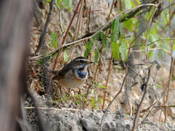search
classification
|
basic information
|
Bluethroat
Luscinia svecica (Linnaeus, 1758)

|
 male
|
|
|
2015-04-26
Tomsk Region, Tomsk |
© Egor Dyachenko
|
|
Description
The Bluethroat is a little bird similar in size to the Sparrow. The male is unmistakable identified by the blue bib edged below with successive black, white and rust coloured borders. Some races have the red spot in the centre of the blue bib; others have the white spot in the centre of the blue bib. The size of the bib and the ratio of the blue, rust, white and black colors are quite variable. Females usually have just a blackish crescent with some blue and rusty feathers (it is expressed very variable on individuals) on the cream throat and breast. Both sexes have the strong white or whitish supercilium and the rusty tail with the broad dark-brown terminal band; the central pair of the tail feathers is plain dark brown. Newly fledged juveniles are freckled and spotted dark brown above and rust with dark-brown color of the tail. In the end of summer juveniles become similar to adults. In autumn plumage birds have a much of rusty tones; males have a bit of blue on the bib; females have more less blue or not have at all. The autumn juveniles and spring (till the middle of the summer) first-year birds are distinguished from the older birds by the wing bar formed by the light buffy borders of the greater coverts. Weight 13-26 grams, length 14-16, wing 6,8-8,5, wingspan 20-24 cm.
Biology
The Bluethroat is common or in places abundant breeding migrant. It inhabits the wet meadows and reed-beds with shrubs; the shrubby river and lake shores; the riparian forests; and the alpine belt with the stones and pygmy birch thickets up to 2500 m. On migration it visits the thickets of tall weeds, groves, forest-belts, gardens and kitchen-gardens. It appears in mid-end March or early April in the southern parts of the range; where the migration continues till the end of May. In the northern areas the first birds recorded in April; and in Altai in the end of April - early May only. It breeds in separate pairs on 30-200 m from each other. The nest is built on the ground under the grass or bush from the dry leaves, twigs, grass and moss and is lined with thin grass, rootlets and hair. Nest is built by female only for 3-7 days. Clutches of 3-6 eggs is in mid-April – early July. Only female incubates for 11-15 days. Both parents feed juveniles fledged at 11-14 days old, in late May – end July. Both adults and juveniles on summer eat insects, just in the end of summer birds eat the berries also. Two broods per summer, repeated breeding after losing of first nest is common. Autumn migration starts in August, birds leave the most of breeding areas in mid-September – end October. The Bluethroat is the earliest dispersal bird on south of Kazakhstan; already in the end of July (latest in early August) it appears in the regions where it even were not in summer. Especially it specific to sub-alpine meadows of Tien Shan. Once upon a time the wintering bird was observed in Dzhabagly village on February 2 1948.
References
















